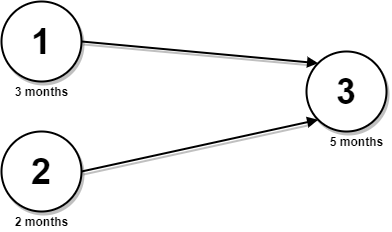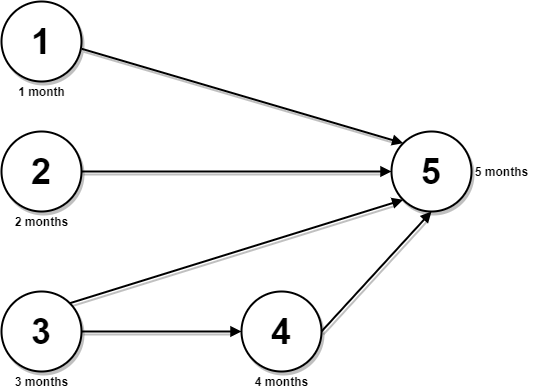2176. Parallel Courses Iii¶
Difficulty: Hard
LeetCode Problem View on GitHub
2176. Parallel Courses III
Hard
You are given an integer n, which indicates that there are n courses labeled from 1 to n. You are also given a 2D integer array relations where relations[j] = [prevCoursej, nextCoursej] denotes that course prevCoursej has to be completed before course nextCoursej (prerequisite relationship). Furthermore, you are given a 0-indexed integer array time where time[i] denotes how many months it takes to complete the (i+1)th course.
You must find the minimum number of months needed to complete all the courses following these rules:
- You may start taking a course at any time if the prerequisites are met.
- Any number of courses can be taken at the same time.
Return the minimum number of months needed to complete all the courses.
Note: The test cases are generated such that it is possible to complete every course (i.e., the graph is a directed acyclic graph).
Example 1:

Input: n = 3, relations = [[1,3],[2,3]], time = [3,2,5] Output: 8 Explanation: The figure above represents the given graph and the time required to complete each course. We start course 1 and course 2 simultaneously at month 0. Course 1 takes 3 months and course 2 takes 2 months to complete respectively. Thus, the earliest time we can start course 3 is at month 3, and the total time required is 3 + 5 = 8 months.
Example 2:

Input: n = 5, relations = [[1,5],[2,5],[3,5],[3,4],[4,5]], time = [1,2,3,4,5] Output: 12 Explanation: The figure above represents the given graph and the time required to complete each course. You can start courses 1, 2, and 3 at month 0. You can complete them after 1, 2, and 3 months respectively. Course 4 can be taken only after course 3 is completed, i.e., after 3 months. It is completed after 3 + 4 = 7 months. Course 5 can be taken only after courses 1, 2, 3, and 4 have been completed, i.e., after max(1,2,3,7) = 7 months. Thus, the minimum time needed to complete all the courses is 7 + 5 = 12 months.
Constraints:
1 <= n <= 5 * 1040 <= relations.length <= min(n * (n - 1) / 2, 5 * 104)relations[j].length == 21 <= prevCoursej, nextCoursej <= nprevCoursej != nextCoursej- All the pairs
[prevCoursej, nextCoursej]are unique. time.length == n1 <= time[i] <= 104- The given graph is a directed acyclic graph.
Solution¶
class Solution {
public int minimumTime(int n, int[][] relations, int[] time) {
ArrayList<ArrayList<Integer>> adj = new ArrayList<>();
for (int i = 0; i <= n; i++)
adj.add(new ArrayList<>());
int[] indegree = new int[n + 1];
for (int[] edge : relations) {
int u = edge[0], v = edge[1];
adj.get(u).add(v);
indegree[v]++;
}
Queue<Integer> q = new LinkedList<>();
int[] finishTime = new int[n + 1];
for (int i = 1; i <= n; i++) {
if (indegree[i] == 0) {
q.offer(i);
finishTime[i] = time[i - 1];
}
}
int res = 0;
while (!q.isEmpty()) {
int u = q.poll();
res = Math.max(res, finishTime[u]);
for (int v : adj.get(u)) {
finishTime[v] = Math.max(finishTime[v], finishTime[u] + time[v - 1]);
if (--indegree[v] == 0) {
q.offer(v);
}
}
}
return res;
}
}
Complexity Analysis¶
- Time Complexity:
O(?) - Space Complexity:
O(?)
Approach¶
Detailed explanation of the approach will be added here